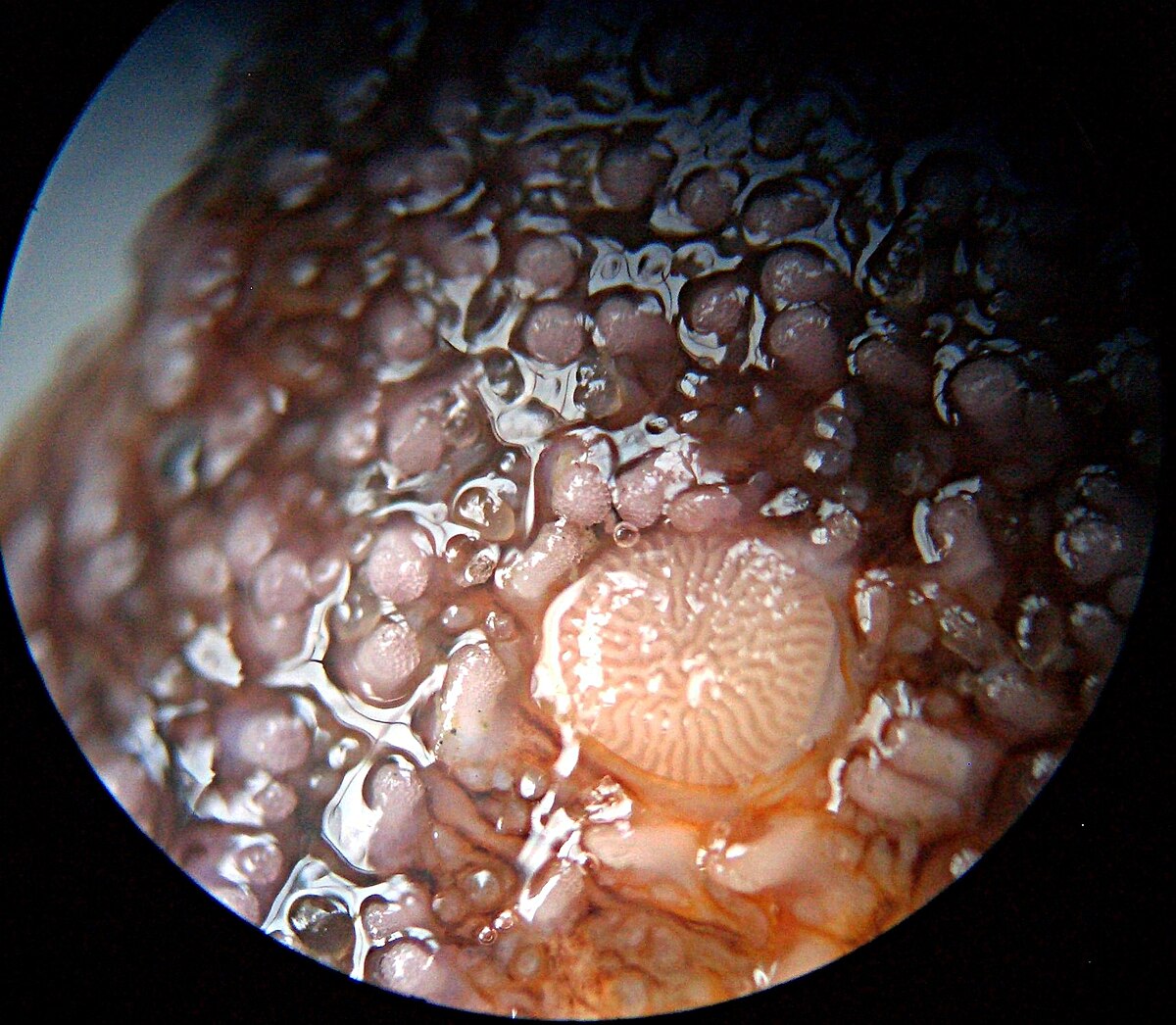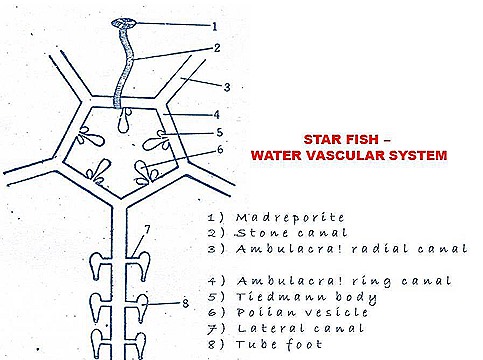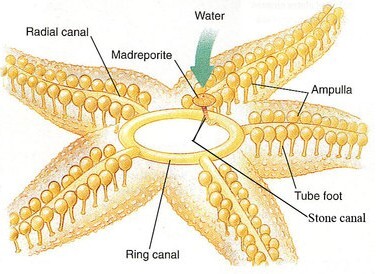STARFISH -WATER VASCULAR SYSTEM
WATER VASCULAR SYSTEM IN STARFISH
In Echinoderms a peculiar system is met with. It is filled with sea water, it is called water vascular system or Ambulacral system. The entire system is lined with ciliated epithelium. This system is well developed in Asteroidea. It contains Madreporite, stone canal, ring canal, 5 radial canals, Tiedemann's bodies, lateral canals and tube feet.

Madreporite: A calcareous plate like structure is present on the aboral surface of the central disc of star fish. It is placed near to two arms and these two arms are called 'Biviurrr.' On surface of the madreporite grooves of furrows are present. Each furrow contains a number of pores. Hence it is called serve plate. These pores led into small canal which open into a stone canal.

Stone Canal: It is a 'S' shaped canal, it is called Madreporic canal. It travels towards the oral side on unite with ring canal at one of inter radius. The walls of stone canal are strengthened by calcarious rings. The inner surface of stone canal is lined with flagellated cells. The movement of flagelia will draw water currents into the stone canal. The wall of the stone canal shows a ridge on one side called 'Lamellated ridge.

Ring Canal: It is penta - radial and is present arround the mouth, on the oral side. At each inner radius, it shows poiian vesicles and Tiedemann's bodies.

Pollan vesicle : In the Asteroidea groups, four muscular like poiian vesicles are present at the 4 inter radi. Some scientists believe that they store water and are considered as reservoirs. Some scientists consider that they produce amoebocytes.
Tiedmann's bodies : Usually in Asterias 9 Tiedeman's bodies are present. On either side of the poiian vesicle two Tiedemann bodies are present. At the stone canal union with ring panal only one Tiedmann body is present. They are lymphoid sac like structures. They are believed to produce amoeboytes.
Radial canals From the ring canal five radial canals arise and run throughout the entire length of the arm. Each radial canal lies below the ambulacra! groove of the oral surface of the arm. Each radial canal ends at the tip of the arm as a tentacle. It is olfactory in function.
Lateral canals From the radial canal of each arm pairs of lateral canals will arise and they end with tube feet.

Tube feet: The basal part of the tube feet is bulged and is called ampulla. It continues as a long tube feet which ends with a 'Sucker'. The ampulla contains circular and longitudinal muscles. The long tube feet like structure contain only longitudinal muscles. Lateral canal will open into ampulla and is guarded by a valve.
Functions of Water vascular System: his mainly used for locomotion and food collection.
1) Locomotor function: The contraction of ampulla extends the tube feet. The tube feet will emerge out of the arm and attaches to the substratum with the help of suckers. The water from ampulla will never enter into lateral canal because of the presence of valves.
The longitudinal muscles of the tube feet will contract and the animal is pulled forward and the Podia becomes short. The fluid is drawn back into the ampulla. Thus relaxation and contraction of tube feet will bring locomotory movement in Star fish. Usually the locomotion is carried on by tube feet of one or two arms in one direction only.
2) Food collection : In order to open the shell valves of the rndhrscan, Star fish utilises its tube feet.-Then it feeds the soft material of Molluscan animals.
How do starfish use water vascular system in feeding?
In the feeding process of starfish, their water vascular system plays a pivotal role. This hydraulic network enables starfish to extend their tube feet outward, forming a network that surrounds and captures prey. By generating suction through the tube feet, starfish firmly grasp onto the prey and then use the hydraulic pressure within the water vascular system to pull the captured prey towards their mouth, situated on the underside of their body. This mechanism not only facilitates the capture of prey but also guides the food towards the digestive system, initiating the feeding process. Overall, the water vascular system serves as a vital tool in the feeding behaviors of starfish, enabling efficient prey capture and consumption.
Why is it called water vascular system?
The term "water vascular system" refers to the hydraulic network found in echinoderms like starfish. This system, filled with fluid, powers various physiological functions including locomotion and feeding. Its name highlights the use of water pressure to drive movement and facilitate essential biological processes, akin to vascular systems in other organisms.
What is the function of the water vascular system in starfish quizlet?
The water vascular system in starfish serves multiple essential functions crucial for their survival and behavior. Firstly, it facilitates locomotion by providing hydraulic pressure to extend and retract the tube feet, enabling the starfish to move across various substrates. Additionally, the water vascular system plays a pivotal role in feeding. It assists in capturing prey by extending the tube feet to envelop the target and generating suction to hold onto it. This hydraulic mechanism also aids in guiding the captured prey towards the starfish's mouth, located on the underside of its body. Moreover, the water vascular system enables starfish to perform gas exchange and maintain internal hydrostatic pressure, contributing to their overall physiology. Through these coordinated functions, the water vascular system ensures the starfish's ability to navigate its environment, obtain nutrition, and maintain homeostasis.
What is the circulatory system of a starfish?
The circulatory system of a starfish, unlike that of vertebrates, lacks a centralized heart and closed blood vessels. Instead, starfish rely primarily on a hydraulic system called the water vascular system for circulation. This system comprises a series of fluid-filled canals, tube feet, and associated structures. It functions by using water pressure differentials to transport nutrients, gases, and waste products throughout the starfish's body. Seawater is drawn into the system through a structure called the madreporite, located on the aboral surface, and is then distributed through the canals. The tube feet, which extend from the canals, play a crucial role in both locomotion and circulation. They can contract and expand, creating pressure changes that help propel fluid through the system. While the water vascular system primarily serves as the circulatory mechanism, some starfish species also possess a simple circulatory system with a ring canal and radial canals, which further aid in fluid distribution. Overall, the circulatory system of a starfish is adapted to their marine environment, efficiently facilitating the transport of essential substances throughout their body without the need for a conventional heart or closed circulatory vessels.

